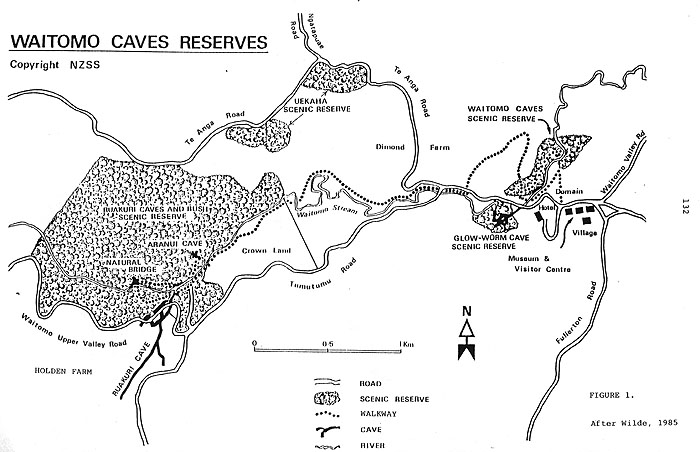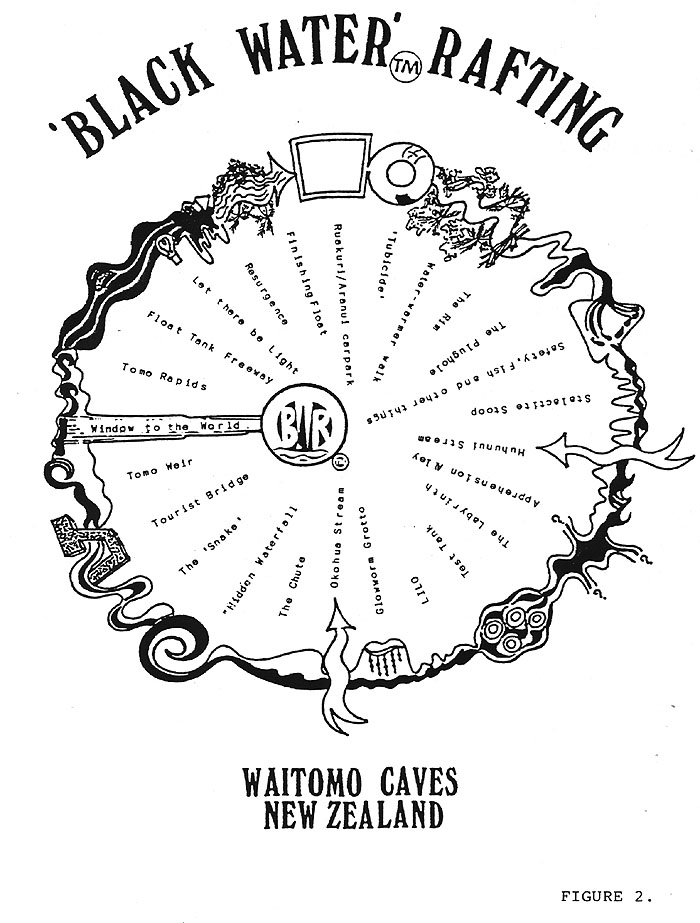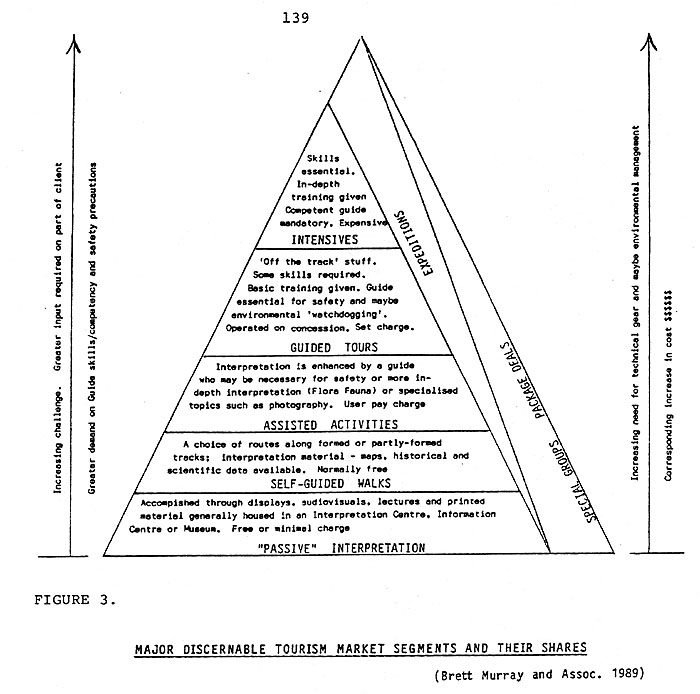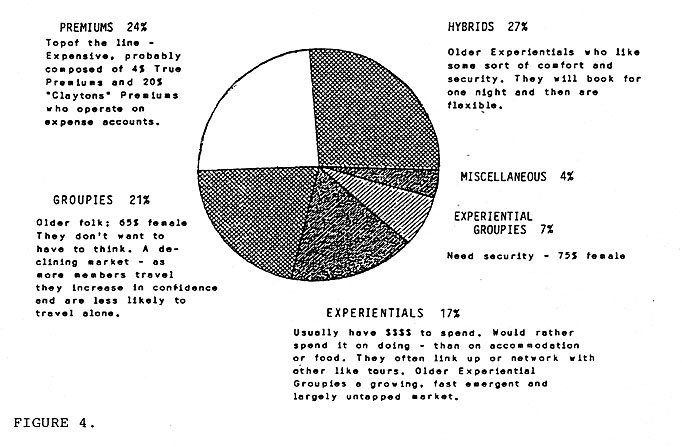ADVENTURE CAVING IN WAITOMO - 1989: CAVES, KARST AND CHAOS?
INTRODUCTION
In 1985 at Waitomo Caves, I (JA) delivered a paper which outlined a philosophical debate I was having with a 'dedicated' caver, Don, over the use of caves for Adventure Tourism. I left that conference concerned, probably a little confused, but committed to following the idea that the conservation and preservation of caves and karst features lay in education and interpretation; in engendering a broad public consciousness and respect. or as Katherine Rhode neatly put it in her discussion on Wind Cave, 'Interpretation - Understanding - Appreciation - Preservation'. The only other alternative is to lose caves completely or enter the battle of gates.
In 1987, Peter Chandler addressed ACKMA about the 'nuts and bolts' of a trip termed 'the Float Thru' which he had initiated in an undeveloped section of one of the other tourist caves at Waitomo, Ruakuri Cave. He left hanging a heavy question mark as to whether or not this 'adventure' trip was just a phase en route to the development of an extensive glowworm boardwalk as outlined by the Tourist Hotel Corporation Caves Manager Dave Williams, who at present is responsible for management of the resource.
It's now 1989, and Peter and I have joined forces, making a commitment to adventure caving in the Waitomo area. 'Blackwater Rafting' is a reality and in its first year of operation has generated an amount of revenue approximately equal to the gross revenue created by processing 20,000 tourists through the regular Ruakuri tourist trip. The only cave modification has been the enhancement of a couple of natural rock weirs; no catwalks, no lighting, no mud, no cleaning. In uniting our energies and talents, we embraced the following goals:
- Self-employment
- The provision of an active facet to the Waitomo Museum of Caves (which is our operations base)
- The provision of the 'best' in underground experiences
- The fostering of an enterprise that would benefit the wider community
- The encouragement of the responsible use, management and monitoring of caves and karst features

Figure 1
The Resource
Blackwater Rafting has been directly propagated out of Ruakuri Cave - the only cave that we know of locally that can support such an activity. It has a special kind of magic - a natural dynamic that encourages comments like 'an experience that is surprisingly gentle and more than a little thrilling'. (NZ Herald, March 4, 1988). The system is some 3-4 km long (Figure 1) and lies within easy reach of the Waitomo Caves Village. Approximately 90% of the surveyed cave (60-70% of the old tourist route) lies under private property, the remainder passing under the Ruakuri Scenic Reserve which is administered by the Tourist Hotel Corporation. This reserve is at present part of a land claim lodged before the Waitangi Tribunal by descendants of the original Maori custodial tribes.
Blackwater Rafting crosses the divide between these two areas (Figure 1) and in essence traces 'nature's plumbing' by following a series of tributaries flowing along joints until one reaches the main 'drain', the Okahua stream, which has developed a large, robust, well-ventilated structurally-controlled passage, dammed at its resurgence by a natural rockfall. Access via the Twin Tomo entrance and exit at the resurgence is convenient and relatively safe and simple.
The inception of the tour has occurred, unfortunately, without any detailed environmental/ecological assessment. Impact from clients is, to some extent, minimised by the cave morphology which presents a watercourse with a clean solid rock substrate or water deep enough to float in. In places, cave waters have built up small silt and gravel levees which undoubtedly contain biota, and ceiling vaults and crevices are occupied by a variety of spiders, harvestmen, centipedes, wetas and gloworms. The streamways themselves are the habitat of eels, fresh-water crayfish (koura), torrent fish and a number of other freshwater forms. Guides are encouraged to keep a log book noting regular sightings of cave biota as well as record water levels at a number of stations throughout the cave. In this manner we are amassing coarse data to which we hope to be able to add more detailed information as expertise becomes available.
Within the Ruakuri system lies the potential for several distinctive tours to be operated simultaneously with very little overlap or interference. The implementation and operation of these trips would necessitate more development and a critical and creative assessment of how the resource should be managed, but will provide the cave with considerable 'texture' which must, in the long term, turn it into a major attraction in the area.
The Trip
The name 'Blackwater Rafting' sprung out of Peter Chandler's mind one night. There's 'white', well, why not 'black'? Obviously it's a gimmick. You're not surging along through black water nor are you pounding down rapids in the depth of night time. The environment, however, is dark and much of the trip is done virtually in the dark or, as we would term it, "glowworm twilight". As far as we know it's a first and because of that we have applied to have the name registered as a trademark.
The duration of the trip is about 3 hours from start to finish which neatly splits into about ½ hour for briefing and outfitting, ½ hour for training manoeuvres and walking to the cave, 1-1½ hours underground and another ½ hour to wind down, shower and partake of a soup and toast snack.
The 'texture' of the trip has evolved as guides have interacted with the resource and observed how their parties react to various situations. One could in fact call it a 'soft roller coaster' - the constant creation and defusing of anxiety where the visitor does not feel totally trapped or out of control. See the mandala (Figure 2).
Guides
Elery Hamilton-Smith said it all in 1985, in telling us that 'the central element which determines the quality of the visitor experience in caves is virtually always the quality of the guiding.' This is reiterated and reinforced by Katherine Rhode in discussing Wind Cave.

Figure 2
We have found that it is the packaging of Blackwater Rafting that has become its major selling point. That is the creative manner in which the guide manages to meld and integrate the parameters of client personality and cave dynamics. In the beginning, guides were encouraged to provide detailed information about the cave and in particular the gloworms and the feeling was that was all important. It was not until we employed some local folk whose experience with caves was almost zero that we began to obtain a true read on our clients' needs and what guide skills were required to meet those needs.
These new guides came with a smattering of speleological knowledge but were able to cope with more complex questions or issues by urging people to seek out information and answers back at the Waitomo Museum of Caves which is set out specifically to interpret cave-related phenomena. They put most of their energy into the people side of the tour, conjuring up a real sense of adventure, keeping the cave mysterious, leaving question marks and massaging natural anxieties - the 'soft roller coaster'. They tended to let the cave speak for itself and concentrated on making the group feel close to sights and sounds and close to each other.
The mix of cavers and non-cavers as staff has been positive. While the former have always been aware of the importance of creating an awareness of the need for cave conservation, the latter have tempered the approach by sowing the seeds underground then letting the newly commissioned projector audiovisual show at the Museum of Caves spell it out (all Blackwater Rafting clients gain free entry to this facility). So far we have been excited by the creative manner in which the guides have approached providing information for the visitor and the effort they put into steering clear of cliches. Comments in the visitors' books sometimes have the management wondering what actually does go on during a trip (Appendix) but obviously visitors are returning feeling good. We are finding that with a few exceptions, quality guides can be found in the so-called non-caver who is excited sharing an experience in contrast to some cavers who are interested in sharing their experience.
One problem lies in maintaining employment continuity - guaranteeing guide availability from our viewpoint and ensuring a steady enough flow of work to make it economically viable for the employee. The ideal guide is a utilitarian - one who has sufficient skill to be involved in other activities such as abseiling and alternative cave tours as well as possibly having another employment bow-string such as farming or opossum trapping. It is also extremely difficult to make time available for staff training when there is a steady demand for tours and where about half of your staff are casuals. We have decided, however, to make a commitment to attempt to continually upgrade guide skills; through workshops, lectures, specialist courses and a continual sharing of personal strengths and talents, even if this should necessitate cancelling trips. The benefit of staff exchanges has not escaped us either, nor has the importance of just going as a group to experience another tourist attraction and informally analysing its positive and negative points.
Safety
Safety and conservation go hand in hand. If you can't operate with a minimum of impact on the resource and at a maximum level of safety then the business should not exist.
Our trip dynamics have been designed so that there is a period of client assessment prior to entering the cave. Guides put visitors through a series of group exercises where they watch for apprehension, non-swimmers vertigo sufferers, those prone to cold, what we'd term the 'fruit cake' factor, and a host of other small things that become important once you are underground. If anyone is to break a leg or have a heart attack the chances are that it will happen before entering the cave. Guides also look for strength, for in any emergency or in adverse conditions it is imperative to know where assistance might lie.
We are fortunate that our tour crosses the original tourist path at about the halfway point, which provides us with a stable area to store emergency equipment as well as allowing a quick, safe, dry and psychologically reassuring evacuation route in case of emergency. Our numbers game has settled on that fine divide between safety and economics - leading to a 1:6 guide/visitor ratio with a maximum of 12 in any one party.
River levels are monitored on all trips and we are fast approaching the stage where we can reasonably predict in-cave conditions by observing level recorders in the Waitomo River and cave resurgence. As more raw data becomes available we should even find that we are able to estimate the approximate time of passing, and maximum height, of flood pulses. The best check, however, still remains sending a guide through on a 'recce' and seeing if they come out again. In extremely high water, we maintain our safety margin by adding an extra guide or maybe even two if the party looks on the weak side.

Figure 3

Figure 4
MANAGEMENT CONCERNS
Monitoring
Neither Peter nor I are managers in the sense of having a background of running a business, dealing with people or looking after a natural resource. We are concerned that if things are done at all then they should be done as well as possible. The resource should still be there in a largely unmodified state generations from now: our staff need to earn a good living, feel that they are professionals and can have input into the system and the business must remain viable whilst at the same time complement the needs and aspirations of the wider Waitomo community. To accomplish this we need to put our finger on the pulse - listen to our clients, our employees and our neighbours.
We have established a system of simple guide and visitor log books. Guides are encouraged to record details of every trip, river data and personal comments about what went right, what went wrong, and things that the management should attend to. To date the free flow of ideas has been encouraging.
All visitors fill in personal 'body bag tags' - detail slips which are then transferred to a visitors book. At the completion of the trip, clients add comments to their slip as well as answer a couple of questions which relate to their behaviour as tourists (method of transport, length of stay, other attractions visited, etc) and the tourist infrastructure of Waitomo. These log books have proved invaluable in exposing the need for changes in routines in order to improve safety, minimise impact on the resource and provide a higher quality experience. They have helped to reinforce or pinpoint business strategy as well as assist in handling complaints and accidents/incidents.
Snowballing
We're all aware that caves have no carrying capacity sensu stricto and that most have limiting factors from a physical as well as aesthetic viewpoint. Blackwater Rafting can be looked upon as a finite business in that we have limited the party size and the number of trips per day in order to protect that sense of wilderness, mystery and adventure that combine to give a quality personal experience. So what do you do when large groups and tour operators as well as travel brokers start pounding on your door? Our philosophy to date has been simple and probably commercially naive. If you run a successful restaurant and people are queuing at the door you endeavour to maintain and enhance what you are doing right and establish an efficient booking system. You certainly don't put up trestle tables and extra chairs; you might open another branch. We are aware that there are other opportunities for guided and non-guided trips in the karst areas surrounding Waitomo as well as the fact that our guides would probably respond in a positive manner to having more than one option in which to be involved. Over the next year, therefore, we propose to initiate a resource study based on the hierarchical structure outlined in (Figure 3) at the end of which we would be able to decide whether or not alternatives are feasible or necessary.
Travel brokers are an interesting breed, who will market your product for commissions of anywhere between 10-30%. Demographically, Blackwater Rafters split almost evenly into domestic travellers and international travellers. Most fall into the 'free independent traveller' (FIT) category and can be broadly described as 'experientials' which is a growth segment in the tourism market (Figure 4). Those that don't are usually domestic and form a group of some description (school, social club, business or conference). Almost invariably these types are not affected by stock market crashes and seem to maintain a high degree of mobility.
Elitism
As was mentioned early on, the rafting trip was, and is, a popular past time with recreational cavers who often term it their 'laundry trip'. What right do these folk have to continued access now that this particular section of the cave has been commercialised?
We would like to think 'every right' and have lobbied with the resource owner to allow this to occur - that bona fide caving club members could still do their 'float thru' provided that it was not at a time which conflicted with a tour. This worked well for a while until there were signs of persons wandering through off limits parts of the cave and abusing this privilege.
The resource owner has allowed us to grant permission to groups but we are becoming more and more acutely aware of the consequences of having some 'bozos' seeing fit to do a little spraycan embellishing or speleothem souveniring. We are contemplating, therefore, introducing a log book for people to sign, as well as limiting access to actual financial members of clubs affiliated to the New Zealand Speleological Society. A concerned landowner would do no less. We are faced with the reality that, under a system of private ownership, the cave owner must have the right to use his resource as he sees fit; to allow freedom of access, charge or lock it up completely. If we're sensible, the former should prevail, although at the time of writing, gating is another option being explored for Two Tone Cave up at Waipu - a superb system used by cavers, commercial groups and, it would appear, 'fruit cakes'.

Figure 5
New Zealand karst is coming of age as a recreational resource. We would like to believe that commercial operators can work alongside recreational cavers and environmental managers to foster the safe, sensible and environmentally sensitive use of caves and karst.
REFERENCES
E. Hamilton-Smith (1985) Improving the Visitor Experience. Proc. 6th ACKMA Conf. Waitomo Caves
K. Rhode (1985) Underground Themes. Proc. 6th ACKMA Conf. Waitomo Caves
APPENDIX
| Magic 10/10 | Wicked shit!! |
| Excellent, something that should be advertised around the world | It was so peaceful, serene. A great experience |
| Holy shit! Must do this again ... sometime! BRILL!! ACE!! | Superb experience. Not too touristy (yet!!) |
| Get with that soup man!! | Enjoyed the terror on my wife's face |
| The orgasm - who needs it! | Totally awesome, better than sex |
| Glad I did it but ... maybe I'll think about it a bit more next time! | Great trip. Had no idea it was going to be all done underground |
| The wildest thing I've done so far. The guides were really good and made the trip the best | No words could describe that! I got weta and weta! |
| I've never bathed with 11 | Guides weren't bad! |
| No words could describe that! | What's the point of a guide if he stays at the back all the time? |
| Was brilliant lovely cave, great fun, crazy guides!! | Great trip. Fascinating and enjoyable. Dave and Angus are two true professionals (I bet Dave will go on to edit the ACKMA Proceedings CD many years from now!) |
| This was very well done! Confident/competent guides with friendly spirit! | Good guides and a sense of humour not to be missed |
| Ball-busting | Pretty wild |
| Far out!! | Excellent experience! |
| Just superb! | Will be back, amazing fun |
| Bizarre ... Back soon! | Absolutely the greatest |
| Brilliant feeling | Fabulous fun |
| Totally awesome |